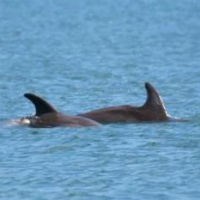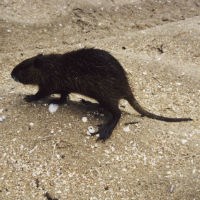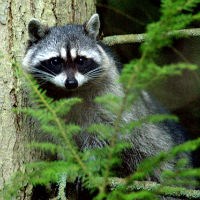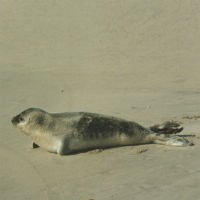
NPS Photo/Victor Pillow Some mammals will give birth to developed young, others will give birth to live young which they nurse in pouches until they develop, and some will lay eggs. The presence of body hair and the ability of mammal mothers to produce milk to feed their young are two of the defining characteristics of this class of vertebrates. Mammals are also the only animals to hear with the help of three bones in their middle ears: the malleus, incus, and stapes. These animals are warm-blooded so many of the calories they consume in their diet go towards maintaining their body temperature. Members of the Class Mammalia range in size from the Kitti's Hog-Nosed Bat (Craseonycteris thonglongyai) which weighs less than a penny to the Blue Whale (Balaenoptera musculus) which weighs about 160,000 kg--roughly equal to 70 midsized cars. Dolphins, whales, rodents, deer, and, of course, the wild horses of Shackleford Banks can all be found in and around Cape Lookout National Seashore. The park monitors the Shackleford horse population and other special interest species. The annual reports for these monitoring efforts can be found on the Wildlife Management page. Some of the most common mammals in this area are listed below. For more complete lists of the mammals found in this park, download the CALO Terrestrial Mammal Species List (pdf, 15 Kb) and the CALO Marine Mammal Species List (pdf, 42 Kb). 
Feral Wild Horse Cape Lookout protects one of the last remaining herds of wild horses on the eastern coast. Although somewhat short for horses--closer to the size of ponies--their stature is most likely a result of their diet. The park controls the population of this non-native species but does not feed, water, or vaccinate them. The horses' diet consists primarily of four grasses on the island: centipede grass, smooth cordgrass, saltmeadow cordgrass, and sea oats. More information is available on the Horses page. 
Common Bottlenose Dolphin Bottlenose Dolphins are the most frequently sighted toothed whales in this area. These dolphins are relatively robust animals and can grow to 8-12 feet in length and weigh between 500 and 1000 pounds. They are light gray on their underbellies and darker gray on their dorsal side. Bottlenose Dolphins are carnivorous, typically feeding on fish and some crustaceans. Though they generally hunt alone, these dolphins occasionally work together to capture prey. 
Marsh Rabbit Marsh Rabbits are about 14 to 16 inches long and weigh 2.5 to 3.5 pounds. The ears, head, tail, and legs of this rabbit are all smaller than those of many other rabbit species. It is also the only member of the genus Sylvilagus with a tail that is not white on the underside. The Marsh Rabbit prefers undisturbed marshland and is an exceptionally good swimmer. 
Nutria These rodents may be best described as beavers with rats' tails. Like beavers, they have webbed hind-feet and long orange teeth which grow rapidly as they wear them down eating. Nutria are herbivores, but can be very aggressive if they feel threatened so it is best not to approach them. Originally from South America, the nutria is a non-native species which was likely introduced into this area to fuel the fur trade. 
Northern Raccoon Raccoons are best known for the black coloring around their eyes which resembles a mask and their brown tails with black rings. They weigh about 13 to 15 pounds and are typically 2 to 3 feet long, with their tails making up a little less than half their length. Raccoons are opportunistic eaters, feeding on crayfish, insects, fish, rodents, bird and turtle eggs, fruits, nuts, and human garbage. 
Western Atlantic Harbor Seal Although Harbor Seals are typically found along the shores of Greenland, eastern Canada, and the northeastern United States, individuals have been found as far south as Florida. They can occasionally be seen sunning themselves on the beaches of Cape Lookout in the late fall, early spring, or winter. These rest periods are important for Harbor Seals, allowing them to warm themselves and conserve energy, so it is crucial that people keep their distance to avoid scaring seals back into the water. |
Last updated: December 29, 2023
